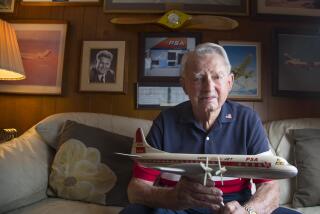PSA President Leaving Position He Thought Was His for a While
- Share via
SAN DIEGO — When Russell Ray left Eastern Airlines in 1985 to become president of Pacific Southwest Airlines, the 52-year-old executive believed that he “had it made” until retirement.
“I really thought PSA could survive as a niche player,” Ray, said shortly after USAir announced that it would acquire San Diego-based PSA for $400 million. “That might sound naive, but that’s how fast things (have changed) in the airline industry.”
Ray will vacate his PSA office at San Diego’s Lindbergh Field on Friday and on Monday will begin as a vice president of customer services, a newly created position, with the Douglas Aircraft Division of McDonnell Douglas in Long Beach.
“This is sort of full circle for me because I began peddling airplanes for Lockheed in Burbank” in 1960,” said Ray, who spent 14 years in Eastern’s marketing department prior to joining PSA in August, 1985.
Involved With New Program
At McDonnell Douglas, Ray will be involved with a new program that will focus on quality control issues for the company’s commercial and military aircraft.
Ray now agrees with former Eastern Airlines Chairman Frank Borman, who predicted in late 1984 that only a handful of the nation’s air carriers would survive a coming wave of mergers and consolidations. That handful of mega-carriers will dominate the nation’s skies at least until the end of the century, Ray predicted.
“There will be some new commuter and feeder airlines popping up, but I really believe that you need transcontinental service to survive,” Ray said.
During recent weeks, Ray spent much of his time dealing with the aftermath of the Dec. 7 crash of a PSA airliner that killed 43 passengers and crew members.
Known for Innovation
Ray said it was “unfortunate” that PSA, long known as an innovative and colorful airline, probably will be remembered for the crash that was believed to have been caused by a disgruntled, gun-wielding former USAir employee.
“All the year-end (news reviews) that I saw had us right up there with Gorbachev and Jim Bakker,” Ray said. “Of course, we’d prefer to have had (PSA) remembered for lots of good things.”
PSA seemed on track toward recording a “good profit” for 1987, according to Ray. However, even a profitable PSA would find it difficult to compete against larger airlines such as United, American, Northwest and USAir, he said.
In addition to time spent on the crash, Ray has overseen the dismantling of PSA as it is merged with USAir. That merger is 90% complete, Ray said, adding that PSA will disappear from the skies in early April.
’. . . They’ll Expand Service’
USAir “is going to maximize use of its (PSA) gates at Los Angeles and San Francisco,” according to Ray. “If anything, they’ll expand service in California.”
USAir may use PSA’s BAe-146 jets, which can carry about 80 passengers, to operate a commuter service in California, Ray said. The Arlington, Va.,-based airline also will give strong consideration to establishing a hub in Phoenix or Las Vegas that would help to connect PSA’s western operations with USAir’s existing service in the Midwest and East, Ray said.
Some of PSA’s MD-80 jets probably will be pressed into transcontinental service and some of USAir’s Boeing-737 jets probably will be used on California routes, Ray said.
Ray is one of many PSA executives who will be leaving the airline during coming months. Many line personnel will remain with USAir in California or back East, Ray said. However, many of the San Diego-based airline’s headquarters personnel will not be working for USAir.
At the top of that list is longtime PSA executive Paul Barkley, the airline’s chairman and chief executive. Barkley, who will step down as PSA chairman within a few months, will continue as president and chief executive of PS Group, the former corporate parent of PSA.
George M. Shortley, PSA executive vice president and Lawrence A. Guske, controller and treasurer, will join Barkley at PS Group.
Ray wasn’t the only PSA executive to incorrectly guess PSA’s eventual fate.
Saw Secure Future
Just three weeks before USAir announced its $400 million bid for PSA, Barkley told airline industry analysts that a “strategically sound, midsized airline” like PSA need not be gobbled up by a large trunk carrier.
“The rumor mill, fed by the speculation of analysts, airline industry employees and the media, is such that you would believe that PSA and many of the other midsized airlines are nothing more than helpless sparrows awaiting the kill by a pack of circling cats,” Barkley suggested.
PSA’s ability to compete, however, deteriorated overnight when American Airlines unveiled its late-November, 1986, bid for Orange County-based AirCal, Barkley said. In fact, American’s announcement prompted USAir Chairman Edwin Colodny’s initial call to Barkley.
More to Read
Inside the business of entertainment
The Wide Shot brings you news, analysis and insights on everything from streaming wars to production — and what it all means for the future.
You may occasionally receive promotional content from the Los Angeles Times.









